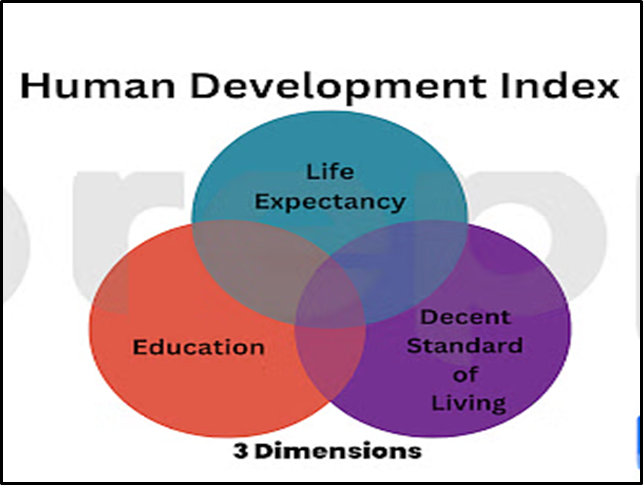GIVING PRIMACY TO HUMAN DEVELOPMENT
Syllabus:
GS-2: Management of Social Sector/Services relating to Health, Education, Human Resources.
GS-3: Economic Development
Why in the news?
Recent reports highlight India’s struggles with inequality and low human development, urging policy reform and prioritisation of welfare.
source:springer
Focus:
- Recent reports highlight concerning trends in India’s development, particularly regarding human development and inequality.
- These reports offer insights for policymakers to address existing challenges and prioritise human welfare in development strategies.
What is the The Human Development Report (HDR)?
Understanding Gender Inequality Index (GII): Gender Inequality Index (GII)
Government Initiatives for Gender Equality:
What is the Global Gender Gap Report?
|
Understanding Human Development Report 2023-24:
- India’s rank in the Human Development Index (HDI) improved marginally from 2021 to 2022, moving from 135th to 134th out of 193
- India’s HDI value increased from 0.633 to 0.644 in 2022, representing progress in human development since 1990.
- Despite this improvement, India still lags behind countries like Bhutan, Bangladesh, Sri Lanka, and China, remaining in the medium human development category.
- The report underscores the need for sustained efforts to enhance human capabilities and welfare, aligning with the goals of major political parties.
- About Trends in Income and Wealth Inequality:
- A study by the World Inequality Lab reveals long-term trends in income and wealth inequality in India from 1992 to 2023.
- The bottom 50% of the population received only 15% of the national income in 2022-23, indicating significant economic disparities.
- The top 1% earned on average 23 times more than the average Indian, exacerbating income inequality.
- Household debt levels reached a record high of 40% of GDP by December 2023, reflecting financial strain on the population.
- Rising inequality poses challenges to economic growth, consumption patterns, and overall human welfare.
- Implications of Inequality and Low Human Development:
- Inequality hinders human development by limiting access to education, healthcare, and economic opportunities.
- Low savings and high debt levels constrain household financial security and impede investment in human capital.
- Skewed income distribution threatens the existence of a robust middle class, potentially leading to social polarisation.
- Addressing these challenges requires a shift towards an alternate growth strategy that prioritises human development over short-term gains.
- Policy Implications and Recommendations:
- Policymakers must prioritise investments in education, healthcare, and social protection to enhance human capabilities and reduce inequality.
- Efforts to increase access to quality education and skill development programs can empower individuals and promote inclusive growth.
- Progressive taxation and social welfare policies can redistribute wealth and mitigate the impact of income disparities.
- Long-term economic policies should focus on sustainable development that fosters broad-based prosperity and ensures social cohesion.
- Political will and bipartisan cooperation are essential to implement reforms that prioritise human welfare and equitable development.
Challanges:
- Uneven distribution of economic growth leads to significant disparities, with the top 10% holding over 77% of wealth.
- Quality of services in healthcare and education remains low despite increased access.
- Lack of proper educational infrastructure hampers quality education provision.
- Malnutrition and undernourishment persist, especially among children, impacting health and cognitive development.
- Social security coverage is lacking, particularly for informal sector workers, affecting access to healthcare and pensions.
- Gender inequality persists in education, employment, and healthcare, with women facing discrimination and violence.
Way Forward:
- India plays a crucial role in sustainable development globally, leading initiatives like the International Solar Alliance and Coalition for Disaster-Resilient Infrastructure.
- It emerged as a key supplier of COVID-19 vaccines and medicines, showcasing commitment to South-South cooperation.
- India’s climate leadership is evident through ambitious targets and commitment to net zero by 2070.
- The country is actively implementing and monitoring Sustainable Development Goals (SDGs) at national and sub-national levels.
- To bridge the gap between economic and human development, India needs a comprehensive approach tackling social, economic, and cultural disparities.
- This includes targeted investments in healthcare, education, and social welfare, alongside efforts to promote gender equality and reduce inequality.
- Tailored development strategies are necessary to address regional and local disparities effectively.
- Address income and gender inequality through policies like equal pay, education, and empowerment programs.
- Invest in education and healthcare, promoting schemes like PMJAY and
- Combat poverty with social welfare programs.
- Promote gender equality through policies against discrimination.
- Protect human rights, ensuring freedom and equality for all.
- Build infrastructure to improve access to basic services.
- Support innovation and entrepreneurship with policies like tax incentives and research grants.
Conclusion:
The convergence of evidence from recent reports underscores the urgent need for proactive measures to address inequality and enhance human development in India.By prioritising investments in education, healthcare, and social protection, policymakers can create an environment conducive to sustainable and inclusive growth.It is imperative for political leaders to prioritise the long-term welfare of citizens over short-term electoral gains and work towards building a more equitable and prosperous society.
Source:The Hindu
Mains Practice Question:
Discuss the recent challenges highlighted in India’s development landscape as depicted in the provided article. Evaluate the implications of low human development, high inequality, and rising household debt on the country’s socio-economic fabric. Suggest potential policy measures to address these issues and outline the importance of prioritising human development in India’s growth strategy.




